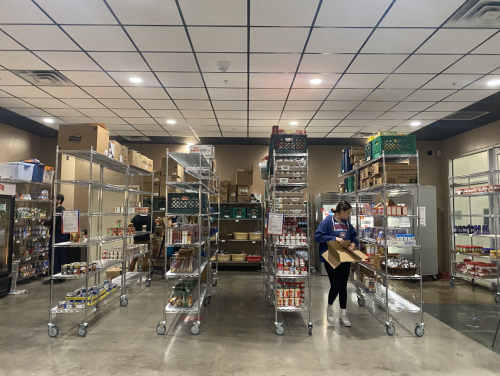Campus Pantry is one solution when students run out of meal plan swipes
Ellia Pannier, El Inde Arizona

The University of Arizona’s mandatory meal plan has proven to be a balancing act for freshmen as many find themselves strapped for CatCa$h and out of meal swipes at the end of each month.
The required plan affected about 6,500 eligible incoming students this year who were able to choose from four different plans that give students 72, 56, 48 or 36 swipes a month for the annual price ranging from $3,880 to $6,510.
Students receive a fixed monthly allocation of meal swipes and dining dollars specific to their plan that they can use exclusively toward the university’s 30-plus markets and restaurants.
While the school limits users to five swipes a day, students are ultimately responsible for managing their monthly swipe and dining dollar budget.
The university introduced the policy last year to encourage students to choose more organized payment methods over debit-style options and increase students’ awareness of campus resources. Moreover, it allows students to select a meal plan that suits their individual lifestyles.
The transition to dorm life can be overwhelming for first-year students like Sarah Yanes, who initially faced challenges budgeting her meal plan and kept running out of swipes. But now she finds herself with excess after a few months of trial and error.
“I think it’s figuring out what kind of eater you are,” Yanes said when explaining her swipe surplus.
Although some may have found their rhythm, there are still concerns over whether all students are getting enough to eat.
The concern is based on the idea that some students may not be using their allocated swipes effectively or that they may not have enough, resulting in insufficient access to meals.
Alexandra Czopek was hired as the assistant director of Meal Plan Programs last year and has kept a close eye on the policy’s progression. Although she’s seen promising usage trends, she said there is still a common problem among first-year students.
“Twelve swipes a week sounds like so many swipes, but that’s not even two meals a day,” Czopek said. “With that nine-swipe situation, you really need to have another source of food.”
Although some students opted for the higher-priced 18 swipes per week, others chose the most economical option with nine. This leaves some students to decide between breakfast, lunch, dinner or a bailout from mom and dad.
First-year student Kason Cox upgraded his nine-swipe plan halfway through the year after regularly having to call home for extra money.
“It wasn’t enough to get through a week,” Cox said, adding that most of his peers are having the same issue.
While upgrades and supplementary funds may be an option for some, not all students have the same lifelines.
Thankfully, students in all situations have an alternative option in the form of the university’s Campus Pantry, located in the Sonora Room on the first floor of the Student Union Memorial Center.
Campus Pantry Coordinator Pete McGraw explained that the pantry anticipates an influx of visitors at the end of each semester as meal plans run out and the stress of school makes grocery shopping an afterthought.
“It’s harder to get to the grocery store and get all the things that you’re able to do throughout the semester,” said McGraw. “We do anticipate seeing a bit more folks… but we’re ready for it.”
McGraw said that 36% of students face food insecurity, yet the pantry’s weekly service only caters to around 4% of the UA’s 53,187 students. He said 2,200 UA students, faculty and staff regularly use the pantry.
“Despite the need being pretty high, a lot of folks still don’t know that we exist,” he said. “There’s a high need, there’s a resource available, but somehow the folks who need it aren’t always being connected with it.”
On Tuesdays, Wednesdays and Fridays students can shop for a variety of free foods including fresh produce, canned goods, spices and essential non-food items including toilet paper and deodorant. The only thing students and the UA community need is a CatCard.
To save time, students can use the pantry’s online ordering and pickup service (https://form.jotform.com/223531409745052) to place orders from Friday to Tuesday and collect them on Thursday at the pantry or the UAHS library, room 1152 (https://form.jotform.com/232430585581154).
El Inde Arizona is a news service of the University of Arizona School of Journalism.
